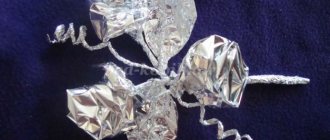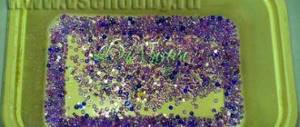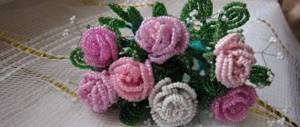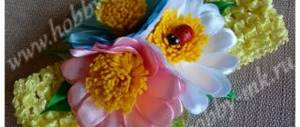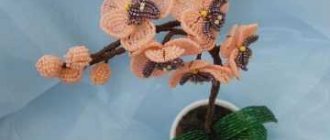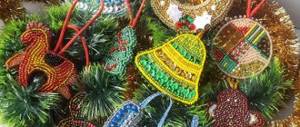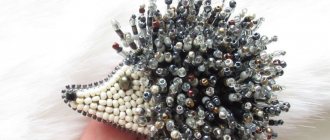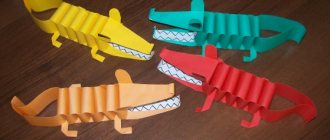Scheme for weaving the composition “Winged Passionflower” » Schemes for weaving trees from beads
The passionflower composition will consist of two open flowers, a half open bud, two buds (of different sizes) and leaves of different sizes.
For weaving you will need:
- beads of dark red, red, white, purple, light green and green colors; - green, red, golden wire; — additional rods; - for the trunk, a piece of stick or tree branch; - floral tape; - flower pots; - decorative pebbles or moss; - plaster; - varnish.
We start weaving with a blossomed flower.
You need to weave 2 rows of petals (inner and outer), stamens and 5 anthers. 1. We weave 5 outer petals using a parallel weaving technique using red beads according to the pattern: 3-5-7-8-9-10-11(5)-10(2)-9-8-7-5-3. To weave one petal you need a wire 50cm long. 2. We similarly weave 5 inner petals from red beads according to the pattern: 3-5-7-8-9-10(7)-9-8-7-6-5-4. The length of the wire for the petal is 50cm.
Then we weave the stamens.
We will make the stamens using the needle weaving technique on a wire 1 meter long. On the middle of the wire we string: 2 green - 1 white - 2 red - 1 white - 2 red - 1 white - 3 red - 1 white - 2 lilac - 1 white - 5 lilac beads. We draw the end of the wire in the opposite direction, bypassing the first lilac bead. We collect 2 rows of beads. Then we string 2 rows of beads according to the pattern: 2 green - 1 white - 1 red - 1 white - 2 red - 1 white - 2 red - 1 white - 3 lilac - 1 white - 5 lilac. Then, alternating rows 2 through 2, we collect 47 rows of stamens. We secure the stamens in a circle using wire. The middle of the flower. Let's make 3 stamens using the needle weaving technique: string 5 yellow and 5 green beads onto a 30cm long wire, twist the wires and make 2 more stamens in the same way.
Let's move on to weaving anthers.
We weave 5 anthers using a parallel weaving technique according to the pattern: 3-4-5-5-4-3-2-1. You need a wire 30cm long.
Then we will make the sepal.
For the sepals we weave 5 petals according to the pattern: 3-5-7-8(3)-7-6-5-4. The petals are woven from light green beads. When weaving the petals, we interlock them with each other after the 8th row. We interlock the last petal with the first and 4 at the same time.
Let's move on to assembling the flower.
Using floral tape, attach the center of the flower with stamens to the rod and wrap the rod 2.5 cm. Then we attach the anthers using floral tape. Next, assemble the 5 inner petals in a circle, passing the wire through the last two beads of each petal. Let's secure the wire well. We will collect the lower petals in the same way, only we will add 2 beads between the petals. Then we insert the collected stamens with anthers into the circle of petals of the inner row and secure them with floral tape, wrapping them about 3 cm. After this, we will insert this blank into the circle of outer petals. Wrap it with 4cm of floral tape. And after that we insert the flower into the sepal.
Half-opened flower.
For this flower we will weave 4 inner petals from red beads according to the pattern: 3-5-7-8(2)-9(4)-8-7-6-5-4-3-2-1. You will need a wire 40cm long. Then, when weaving, we will interlock the remaining 3 petals with each other starting from the 6th row. In a similar way, we weave the outer petals from light green beads, on a wire 40 cm long, according to the pattern: 3-5-7-8-9-10(5)-9-8-7-6-5-4-3-2 .
We weave the stamens as for the open flower.
Then we weave the anthers using the needle weaving technique. We string 3 large yellow beads, 4 yellow, 3 green for each stamen.
Let's start assembling the half-opened flower.
We attach the stamens and anther to the rod using floral tape, then insert them into the circle of inner petals, then into the circle of outer petals using light green beads. We secure it with floral tape and wrap the rod 4cm.
Let's move on to weaving buds.
We weave the middle bud. It will consist of 3 red and 4 green petals. We weave red petals according to the pattern: 2-3-5-7-8-9(4)-8(2)-7(2)-6-5-4-3-2. The wire is needed 40cm long; we interlock the petals with each other when weaving. Similarly, on a wire 50 cm long, we weave petals from green beads according to the pattern: 3-5-6-7-8-9(2)-8(2)-7(2)-6-5-4-3-2.
Small bud.
Red petals on a 40cm long wire according to the pattern: 2-3-5-7-8(5)-7(2)-6-5-4-3-2. Green petals on a 40cm long wire according to the pattern: 3-5-6-7-8(3)-7(2)-6-5-4-3-2-1.
Let's move on to assembling the buds.
Using floral tape, attach the red petals to the stem, then insert the red petals into the green ones, and wrap the stem with 5cm of tape.
The next stage is weaving the leaves.
A passionflower leaf consists of 3 leaflets linked together. For the composition we will weave 5 large leaves, 14 medium and 3 small leaves using the parallel weaving technique.
We weave a large sheet of green beads according to the pattern:
1 sheet: 1-3-5-6-7-8-9-10(3)-9-8-7-6-5-4-3-2-1. 2 sheets: 1-3-4-5-6-7(5)-6-5-4-3-2-1-1. 2 sheets: 1-2-3-4-5-6(4)-5-4-3-2-1-1.
Middle sheet:
1 sheet: 1-3-4-5-6-7-8(4)7-6-5-4-3-2-1-1. 2 sheets: 1-3-4-5-6(4)-5-4-3-2-1-1. 2 sheets: 1-3-4(4)-3-2-1-1.
Small leaf:
1 leaf: 1-3-5-6-7(5)-6-4-3-2-1-1. 2 sheets: 1-3-4-5(5)-4-3-2-1-1. 2 sheets: 1-3-4(4)-3-2-1-1. We will fasten the leaves to each other from the bottom row with 5 beads. Let's put together our composition. We attach a small bud to the rod using floral tape and wrap it with 5cm of tape. Then, 2cm from the bud, attach a small leaf. Then we will distribute 1 large, 4 medium and 1 small leaves, approximately 3 cm apart from each other. Then we attach 1 bud and a half-open flower between the leaves. This will be our central branch. Let's move on to the formation of the middle branch. Attach a small leaf to the rod and then place 5 medium leaves on the branch at a distance of 5 cm from each other. After this we form 2 large branches. Using floral tape, attach a large flower to the rod, and attach 2 large leaves at a distance of 3 cm. Then we attach 2 medium leaves in between the two large branches, with open flowers, in order to give the composition a more natural look. Let's make another middle branch. We attach a small sheet to the rod, at a distance from each other we attach another 1 large and 3 medium sheets. For the trunk, we will take a piece of a tree branch, which we will paint with green paint, which will be entwined with passionflower. The trunk and branches are carefully wrapped with floral ribbon or green silk threads. We will install the finished composition in a flowerpot, securing it with plaster, on top of which we will place moss or decorative stones.
After which we will coat the barrel with varnish.
rukodoma.ru
Leaflets
We weave leaves of three sizes: No. 1 large, No. 2 medium, No. 3 small. They are woven the same way, except for the number of arcs.
Leaf No. 1: 8 pairs of arcs around the central axis, 5 beads on the central axis, the eighth pair of arcs is edging; Leaf No. 2: 7 pairs of arcs around the central axis, 5 beads on the central axis, the seventh pair of arcs is edging; Leaf No. 3: 6 pairs of arcs around the central axis, on the central axis there are 5 beads, the sixth pair of arcs is edging.
Let's look at weaving using the example of middle sheet No. 2. We take a piece of green axial wire about 10-12 cm long; beads of the main color are strung on the working wire. We twist them together and make two pairs of arcs with the main color (we have 5 beads on the axis).
We measure the required length of the working wire (wind five turns around 3-4 fingers) and cut the wire from the spool. Starting from the third arc, add 1 bead at the base of the leaf (the color is the same as the edging one). And on the tops of the leaves we add a second shade of cutting.
And we continue to add more and more beads (with each arc) at the base of the leaf.
We make the final row with completely edging beads.
The leaf is ready!
In total we got 4 large leaves, 8 medium ones and 4 small ones. We collect twigs from them: two - three leaves each and two - five leaves each.
Assembling twigs
Take one leaf No. 1, two leaves No. 2 and No. 3.
Cover all stems, except leaf No. 1, with floral tape. We take a piece of gerbera wire about 20 cm. We wrap all the leaves one by one with assembly wire (or thread).
Then we decorate the entire stem with floral ribbon.
We do this with all the leaf branches.
Passionflower Cavalry Star
Materials
beads, wire, beads, plaster, pva, satin ribbon, masking tape, crepe. paper, colorless varnish, stones for decoration
Preparation method
First I wove the petals using the parallax weaving technique, then the stamens using the needle technique and the center, and finally the leaves
Step by step photos
Source: My BUNNYMaterials Thin and thick wire, small green beads, large yellow beads, yellow and green beads, masking tape, flor.
tape, stand, claim. leaves, Moment glue, plaster, St. green nail polish. Manufacturing method Loop weaving. I wove 50 branches. I made branches of different colors from 3 thick wires. Materials: Beads of different colors, thin wire, 2 hairpins, plaster, PVA glue, masking tape, flor. green ribbon, stand. Manufacturing method Loop weaving technique. Step-by-step photos Source: by-hand.ru Dancing tree Materials Thin and thick wire, rock crystal beads, acrylic paint, masking tape, cup, silver powder, PVA glue, plaster. The method of making Plela is as usual. Step-by-step photos Source: by-hand.ru I SITT WELL Materials Thin wire, white, yellow beads, souvenir - Frog, flor. tape, glue moment. Manufacturing method Weaving the petals towards each other - 1-2-3-4-5-5-5-4-3-2-1. I wove 30 petals, 6 petals per flower, 5 flowers in total. The leaves of the weave are woven towards each other - 1-2-3-4-5-4-3-2-1, woven 9 Comments (0)
Comments
mirbisera.com
Sepals
For one rose you will need five sepals of different sizes.
Using the example of the middle sepal, we will consider weaving blanks. Take a piece of wire about 10 cm long and the working wire 4-5 turns around your fingers. We collect three beads on the central axis and make two pairs of arcs, adding 3-4 green beads at the base of the sepals.
The size of the sepal can be adjusted by the number of beads added to the central axis. This time we add 1 bead before the third arc.
Before the fourth arc, add four beads to the central axis.
Before the fifth pair of arcs there are 2 beads.
The sepal is ready! In this way we make five different sepals. Sepal size: from 3.5 cm to 6 cm long.
Beading Tools
- Scissors. Wire cutters. For cutting wire, tape, thread and more.
- Threads, tape or floral tape. For wrapping twigs, stems and tree trunks, as well as for wrapping branches to each other and to the trunk. For winding, you can take the simplest threads in spools with which we sew. To wrap the flower branches, use floss threads of green or other desired color. Sometimes they take yarn and wrap it around the trunks of bonsai trees. But I don’t really like this option, imagine how dust collects on the yarn... of tape or floral tape . Floral tape or tape of different quality. It is also used to wrap or wrap branches, saving a lot of time. I once ordered and received a very nice, thin, and less sticky tape than the one I bought in the sewing supplies department - it was clearly of cheap quality, very sticky and seemed thicker, but it also cost a little less, I note A little (!). Therefore, I think it makes sense to order such a universal thing as tape in florist supply stores.
- Gypsum. For coating tree trunks with a mixture of PVA + gypsum, and for planting and pouring products.
- PVA glue. Also necessary for coating the trunk and branches, and for gluing decor. I use the simplest construction one in a bucket.
- Dishes for planting. Everything is clear here. You can take bowls, flowerpots, ceramic or plastic pots for indoor flowers, pallets and much more.
- Decor. Moss, sisal, artificial grass, dyed and finely chopped paralon, beads, pebbles, shells, figurines, ladybugs are used as decoration... The list goes on. Decorate as your imagination dictates.

